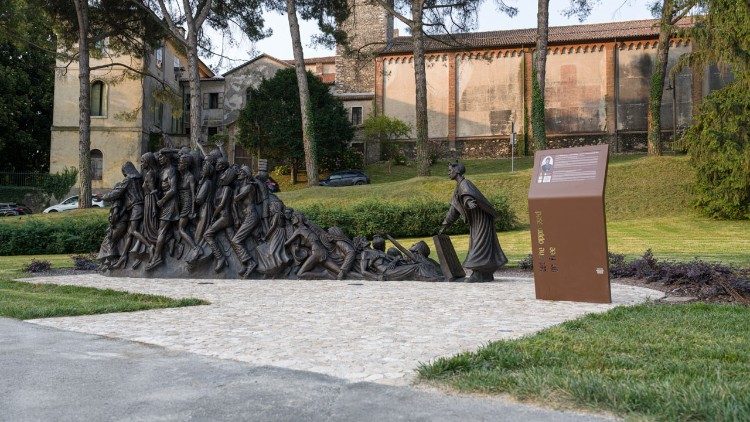
'Let the Oppressed Go Free' sculpture shines light on human trafficking
By Zeus Legaspi
“Horrible modern-day slavery is everywhere and it’s kept hidden,” said Timothy Schmalz, a Canadian sculptor. Mr. Schmalz has been a sculptor for almost 30 years and has produced various bronze sculptures depicting social issues, turning Scripture and the Holy Father’s words into works of visual art.
On the sidelines of the Wednesday General Audience, ��MAP���� Francis blessed a small-scale model of Mr. Schmalz's most recent bronze sculpture about human trafficking.
Entitled, “Let the Oppressed Go Free”, the 20-foot sculpture weighing over three tons depicts St. Josephine Bakhita opening a trapdoor as she frees figures that represent trafficking victims from diverse backgrounds.
The sculpture took inspiration from Isaiah 58:6 and the ��MAP����’s vocal stance on human fraternity and fighting human trafficking. “The power of this piece was confirmed when I was reading some comments that ��MAP���� Francis made on human trafficking, and he said, human trafficking will always exist if kept underground. I looked at my sculpture and I thought, ‘these are the words of ��MAP���� Francis with the hero being St. Bakhita’,” the artist explained in an interview with Vatican News.
St. Josephine Bakhita
St. Bakhita is the patron saint of Sudan and of victims of human trafficking. The Saint bore 144 scars as a result of her abduction and enslavement at the age of 9. She endured a life of violence and mistreatment during her years as a slave. She later converted to Catholicism and was placed under the care of the Canossian Sisters. She was canonized in 2000.
“I think that the powerful thing about that was (that) she was a slave from a previous century. And here she is freeing the slaves of today,” Mr. Schmalz said, referring to St. Bakhita as the focal point of his sculpture.
While researching the topic, the sculptor had a chance to reflect on the reality of human trafficking in the world. “When you understand human trafficking, it’s a slap in the face. It’s saying we’re basically living as brutal to our brothers and sisters as ever right now,” he said.
Mr. Schmalz spoke about how this offense to human rights is a “deep, disturbing element of humanity” and what was preventing people from talking about it is rooted in not wanting to dwell on something so evil. He believed that his massive bronze sculpture would bring the subject to light.
Sculptures as visual prayers
The Canadian artist has said in the past that his artworks serve as “visual prayers”. His prayer for “Let the Oppressed Go Free”, Mr. Schmalz said, is one of hope.
“When I look at this when I see her (St. Bakhita) opening up the ground and the oppressed going free, there is that hope there. There is that hope that we can absolutely destroy human trafficking in the world.”
“There is that freedom, that destruction of oppression and slavery represented within this,” he added.
Raising awareness
When asked how his sculpture helps the ��MAP����’s endeavor to spread the message of human fraternity and promote human rights, the sculptor explained that he believes his work could serve as a form of evangelization and an exclamation point to an ugly reality.
“Just by the existence of this piece out there, taking up that space is going to bring that awareness of human trafficking,” he said. “I think it’s one of the best things artwork can do. If it can stop human trafficking, if it can…bring awareness of what’s happening under basically every city.”
“The first step is awareness. So, I’d consider this a weapon to fight human trafficking,” he added.
On Thursday, 29 June, Mr. Schmalz’s latest work will be installed near the Church of Saint Francis of Assisi in the Italian city of Schio. The event will be attended by the Vatican Secretary of State, Cardinal Pietro Parolin, and Schio’s Mayor, Valter Orsi, among others.
Thank you for reading our article. You can keep up-to-date by subscribing to our daily newsletter. Just click here








